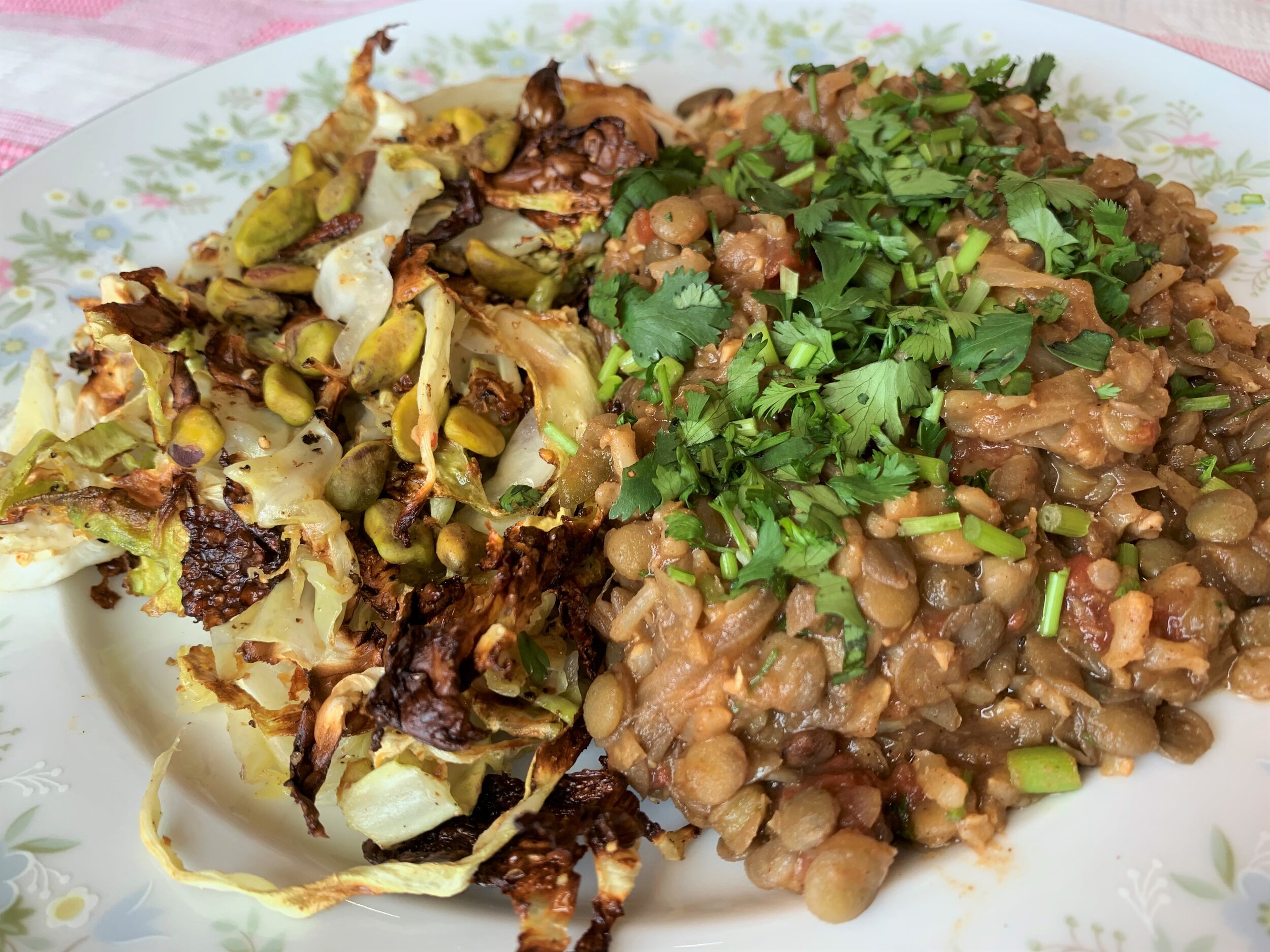Wannabe Kosheri
I hesitate to call this dish Kosheri because I took a Kosheri recipe and modified it to not have to buy ingredients I typically wouldn’t use (that’s you vemicelli noodles) and to reduce the number of dirty dishes. I also amped up the acid level — that was by mistake about 6 years ago and I haven’t gone back. Know that I am aware this is not authentic (I will accept tongue lashings), but also know this is delicious.
Kosheri is an Egyptian street food and is a great segway into eastern Mediterrean cuisine because its ingredients are common in an American Kitchen. You can eat it at room temperature with a simple cucumber salad with a yogurt dressing or serve warm with roasted cabbage. The combination of rice and lentils creates a complete protein. If you’re someone who needs animal protein to call it a meal, well-seasoned chicken or white fish pairs well with it. Make sure it’s well-seasoned or the flavor of the protein will get lost.
I have recipe notes at the bottom, make sure your read them before you make the recipe or go grocery shopping.
Serves 4
Rice Mixture Ingredients
3 T unsalted butter
1.5 t chicken base
1 c of basmati brown rice (or other rice)
water (follow the directions on the rice bag)
½ t ground nutmeg
1.5 t ground cinnamon
1 t salt
½ t ground black pepper
Tomato Mixture Ingredients
4 T olive oil
2 large cloves garlic, crushed and minced
2 hot red chiles, seeded and finely diced (can use jalepenos or serrano if that’s what you have)
14.5 ounces, canned small diced tomatoes
1.5 c water
4 T apple cider vinegar
1/2 t salt
2 t ground cumin
2/3 ounce cilantro chopped
Lentils Ingredients
4 T olive oil
2 white onions, halved and thinly sliced
1.5 c lentils
½ t salt
½ t ground black pepper
Garnish: Chopped cilantro
Rice Mixture Directions
Melt the butter in a saucepan over medium heat. Add rice and stir to coat it in butter and allow the rice to pick up a tad of color. Add the chicken base, water (follow the amounts on the rice bag), nutmeg, cinnamon, salt, and black pepper. Cook the rice according to the directions (different types of rice need different water amounts and cooking times). When it’s done cooking, fluff it with a fork. Taste and adjust seasonings.
Tomato Mixture Directions
Heat olive oil until it shimmers into a saucepan. Add the garlic and chiles and fry until the garlic is a light golden color. Please be careful because garlic can go from delicious to bitter in two blinks of an eye. Add the tomatoes, water, cider vinegar, salt, and cumin. Simmer until thickens (think a thick red gravy – also known as marinara). Remove from heat and add cilantro. Taste and adjust seasonings.
Lentils Directions
Add olive oil into a saute pan. Heat it until it shimmers. Add the onions and you should hear a little sizzle. If it’s not sizzling, no worries, just turn up the heat. If it’s plenty sizzle and/or see smoke, lower the heat. Different stove burners are different levels of hot so it’s hard to tell you a heat level. Medium low is a good starting place. You want the onions to turn clear then begin to caramelize. If the edges of the onions begin to brown or blacken and the interior is still white, the burner is too hot. If the onions are hanging out without much action, bump the heat up a little. Adjust the heat level as needed. You want to let onions sit so they brown, but you do need to stir them occasionally. When the onions are sticking plenty and you’re getting stuff stuck on the bottom of the pan, add a little water to deglaze and allow them to brown again. You want the onions dark, and I mean dark (like dark chocolate dark).
When onions are where you want them add the lentils and enough water to cover them. Bring the water to a simmer and allow to cook. When the water is out, taste a lentil, it should have a little bite, but not firm. Adjust seasonings. If they are too firm, add water and keep simmering.
Assembly
Mix the three components together and add 3T of vinegar. Stir. Taste and adjust seasonings.
Top with cilantro.
Notes
Rice: We try really hard to have a whole grain diet so we always use brown rice. Basmati or a long grain rice works well here as the grain stays separate, but whatever you have will do. If you’re typically a white rice eater, use that.
Salt: There are too many salts in this world to count and they have different levels of saltiness. I use a fine sea salt, but it is coarser than regular table salt which means table salt by volume is already more by weight. I slightly reduced the salt amounts to avoid the dish getting too salty if you have a salty salt. I encourage you to try using the written salt amounts or reducing it when you cook it. You can always add more salt as needed, but can’t take it away. But please, please, please salt your food while cooking it. The salt needs to infuse the ingredients. By only adding salt at the end of cooking (or at the table), you’ll end up using more salt for an inferior result.
Chicken Base: Do not go out and buy base or stock for this dish. If you don’t have chicken, use beef or whatever you typically use. I like a base because it’s a space saver and cheaper than a box of stock or broth. But if you’re a stock/broth person, use it in place of the base.
Vinegar: If you’re sensitive to acid, omit the vinegar at the last step or add 1t at a time until it’s enough for your liking.

